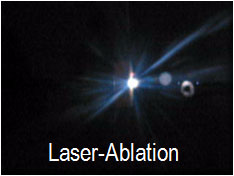Laser Plasma Technology for Simultaneous Surface Decontamination and Characterization
Highlights:

- Explore fundamental science of surface decontamination by laser ablation
- Simultaneous cleaning and characterization of radionuclides and heavy metals contaminated surfaces
- High-rate decontamination process
- Particles produced can be collected and filtered by HEPA
- Does not produce secondary water pollution like current wet cleaning methods
Decontamination and decommissioning (D&D) of nuclear facilities is a major effort at the DOE complexes across the United States. Large quantity of demolished building materials have to be removed and characterized before they can be hauled away for final burial. The goal of this project is to develop an advanced technology for cleaning surfaces of concretes and stainless steel materials contaminated by radionuclides and heavy metals. Laser ablation is a versatile and rapid cleaning method; it produces no secondary water pollution. This ORNL-developed laser-ablation method also enables simultaneous verification of the decontamination process by coupling the laser-induced plasma emission signals produced in the decontamination step. Thus, there will be no wait time for verification of decontaminated materials. Particles produced as a result of the surface decontamination process can be easily trapped by a HEPA filter causing no health effects to the workers or the environment.

Fundamental understanding of the production of the particles, particle properties, and particle formation dynamics is critical in optimizing the cleaning technology and developing an effective engineering approach for decontamination and protection of workers from exposure to the toxic particles. We have performed extensive laboratory experiments to investigate how laser interacts with different materials using selected target surfaces prepared from the Portland cement doped with or without toxic heavy metals, stainless steel 316, and alumina. We have parameterized the relationships of particle formation and laser parameters (e.g., wavelength and energy) useful for engineering design and operation.
Selected Publications of this Project:
- Qi, C., D.-R. Chen, and M.-D. Cheng (2007) Using a Fast-Scanning Electrical Nanoparticle Sizer to characterize Nanoparticles from Laser Ablation, Aerosol and Air Qual. Res., 7(1): 1-16.
- Chen, D.-R., W. Li, and M.-D. Cheng (2006) Development of a Multi-Stage Differential Mobility Analyzer, Aerosol Sci. & Technol., 41(2): 217-230.
- D.-W. Lee and M.-D. Cheng (2006) Particle Generation by UV-Laser Ablation During Surface Decontamination, J. Air and Waste Manage. Assoc., 56:1591-1598.
- Cheng, M.-D. and D.-W. Lee (2005) Investigation of Nanoparticle Formation during Surface Decontamination and Characterization by Pulsed Laser, Proceeding of American Chemical Society, Environmental Management Science Program, Accepted July.
- Cheng, M.-D. and D.-W. Lee (2005) Laser-Generated Airborne Particles during Surface Decontamination, European Aerosol Conference, August.
- Lee, D.-W. and M.-D. Cheng (2004) Particle Generation by Laser Ablation during Surface Decontamination, J. Aerosol Sci., 35:1527-1540.
- Lee, D.-W. and M.-D. Cheng (2004) Investigation of Nanoparticle Generation during Surface Decontamination by Laser Ablation at Low Fluence, J. Aerosol Sci., 35:1513-1526.
- Lee, D.-W. and M.-D. Cheng (2004) Investigations of Nanoparticle Generation during the Laser Ablation Decontamination, American Association for Aerosol Research National Meeting, Atlanta, GA, October.
- D.-R. Chen, D.-W. Lee and M.-D. Cheng (2004), Nanoparticle Dynamics in Laser Ablation Process, American Association for Aerosol Research National Meeting, Atlanta, GA, October.
- Cheng, M.-D. (2004) Particle Characterization by Nonlinear Aerosol Plasma Spectroscopy, the 7th International Conference for Optical Particle Characterization, Kyoto, Japan, August.
- Cheng, M.-D. and D.-W. Lee (2003) Investigation of Nanoparticle Formation During Surface Decontamination and Characterization by Pulsed Laser, Proceedings of the EMSP Symposium on Nuclear Waste Management of the 226th American Chemical Society National Meeting, New York City, NY, September, invited.
- Cheng, M.-D. and D. R. Chen (2003) A Stackable Differential Mobility Analyzer for Aerosol Measurement, DOE ID 1341, S-101,935, November 20, 2003.
- Cheng, M.-D., Doh-Won Lee, and Baohua Gu (2003) Investigation of Nanoparticle Formation During Surface Decontamination and Characterization by Pulsed Laser, invited, the National Meeting of American Chemical Society, New York City, NY, September.
- M.-D. Cheng (2002) An Aerosol Beam-Focused Laser-Induced Plasma Spectrometer, U.S. Patent No. 6,359,687.
- Lin, Y. L. and M.-D. Cheng (2002) Removal of Contaminants from Target Surfaces by Laser Ablation: Formation of Nanoparticles, Presented at the 2002 National Meeting of American Association for Aerosol Research, Charlotte, NC, October.
For more information, contact:
Meng-Dawn Cheng (chengmd@ornl.gov, 865-241-5918)

